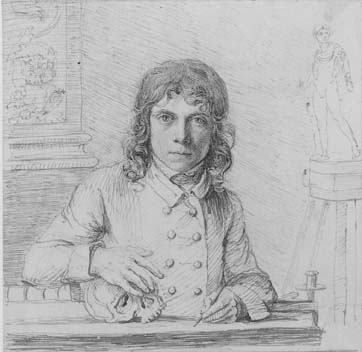
Born: 6 July 1755, London
Died: 7 December 1826 (aged 71)
Period: Neoclassicism
Known for: Sculpture
The Life of John Flaxman
John Flaxman (1755–1826) was an influential British sculptor, illustrator, and draughtsman, renowned for his work in the Neoclassical style. His life and career can be summarized as follows:
Early Life
- Born in York on July 6, 1755, Flaxman showed an early interest in drawing and sculpture. He was the son of a mold maker for the pottery industry, which provided him with a foundational understanding of sculptural forms.
Education and Early Career
- At a young age, he started studying at the Royal Academy of Arts. Despite facing health challenges, Flaxman’s talent in sculpture quickly became evident.
- He earned his living by creating funerary monuments and small sculptural works, which displayed his skill in working with classical themes and figures.
Marriage and Italy
- In 1782, Flaxman married Anne Denman, who was supportive of his career. The couple moved to Italy in 1787, where Flaxman spent several years studying and working. This period was crucial for his development as an artist; he immersed himself in classical art and literature, which significantly influenced his style.
Return to England and Later Career
- Upon his return to England in 1794, Flaxman opened a studio in London. He became a sought-after sculptor for monuments and memorials, notably contributing to Westminster Abbey and St. Paul’s Cathedral.
- Besides his sculptural works, Flaxman was highly regarded for his illustrations, especially those for Homer’s “Iliad” and “Odyssey,” Dante’s “Divine Comedy,” and Aeschylus’s tragedies. These works were celebrated for their simplicity and expressive lines, embodying Neoclassical ideals.
Academic Involvement and Legacy
- Flaxman was actively involved in the Royal Academy, where he was elected an associate member in 1797 and became a full Academician in 1800. He later served as the Academy’s Professor of Sculpture.
- His lectures and writings on art influenced future generations of artists, emphasizing the importance of classical forms and themes in modern art.
Death and Impact
- John Flaxman passed away on December 7, 1826, in London. His legacy endures through his contributions to Neoclassicism, his innovative approach to sculpture and illustration, and his influence on later artists.
- Flaxman’s works are preserved in various institutions worldwide, including the Uffizi in Florence, the Royal Academy of Arts in London, and the Metropolitan Museum of Art in New York, showcasing the enduring appeal of his art.
John Flaxman’s life was marked by his dedication to art, a profound understanding of classical antiquity, and his ability to influence and inspire through his works and teachings. His contributions to Neoclassicism and the art world at large remain significant, reflecting his talent, vision, and impact on future generations.
John Flaxman’s Notable Works
John Flaxman is celebrated for his contributions to sculpture and illustration, particularly within the Neoclassical movement. Here are ten of his most famous works, which span both these disciplines and highlight his versatility as an artist:
- Illustrations for Homer’s “Iliad” and “Odyssey” (1793) – These are perhaps Flaxman’s most renowned illustrations, acclaimed for their simplicity and clarity. They played a significant role in defining the visual interpretation of Homer’s epics during the Neoclassical period.
- Illustrations for Dante’s “Divine Comedy” (1793) – Flaxman’s drawings for Dante’s epic poem are celebrated for their expression of the poem’s drama and emotion through minimalistic lines, embodying Neoclassical ideals.
- Monument to Lord Nelson (1808-18), St. Paul’s Cathedral, London – This memorial commemorates the famed British naval hero Admiral Horatio Nelson and is one of Flaxman’s most significant sculptural works, showcasing his talent in creating grand commemorative sculptures.
- “Cephalus and Aurora” (1789-90) – This sculpture is an early work that reflects Flaxman’s deep engagement with classical mythology and storytelling through sculpture.
- Monument to George Steevens (1800), St. Paul’s Cathedral, London – This funerary monument is another example of Flaxman’s ability to convey character and virtue through sculptural form.
- “The Fury of Athamas” (1790-94) – This dynamic sculpture captures a moment from classical mythology with dramatic intensity and is noted for its emotional power and expressive forms.
- Illustrations for Aeschylus’s Tragedies (1795) – These works further exemplify Flaxman’s skill in illustrating classical texts, capturing the tragic depth of Aeschylus’s plays with minimalistic elegance.
- Monument to Sir Joshua Reynolds (1813), St. Paul’s Cathedral, London – Flaxman paid homage to Reynolds, the first president of the Royal Academy, with this monument, reflecting both men’s contributions to British art.
- “St. Michael Overcoming Satan” (1820) – This relief shows Flaxman’s ability to depict religious themes with vigor and a clear moral contrast between good and evil.
- Monument to William Murray, 1st Earl of Mansfield (1796), Westminster Abbey, London – This work commemorates an important British jurist and statesman, illustrating Flaxman’s capacity to honor public figures through his sculptural art.
John Flaxman’s famous works demonstrate his mastery of form and line, his engagement with classical and contemporary themes, and his profound impact on the Neoclassical movement. His artistry in both sculpture and illustration has left a lasting legacy in the history of art.